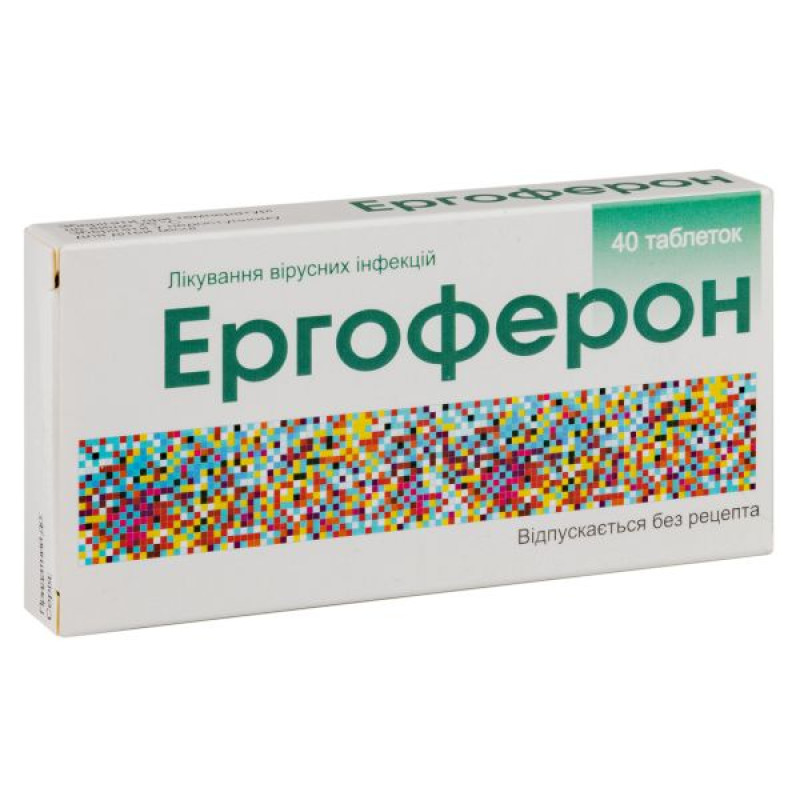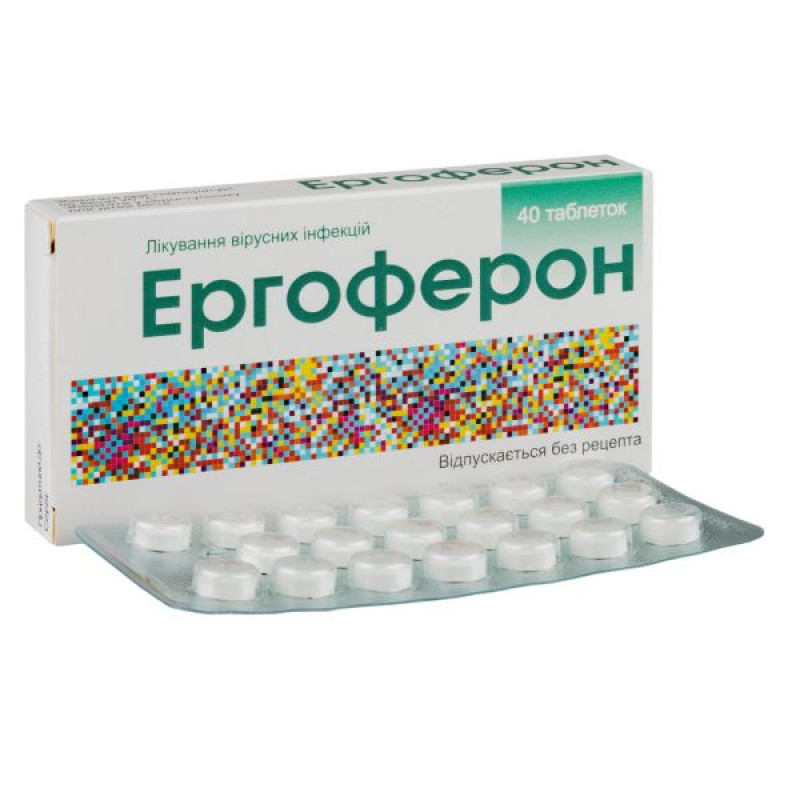Ergoferon tablets No. 40

Instructions Ergoferon tablets No. 40
Composition
active ingredients: 1 tablet contains: affinity purified antibodies to human gamma interferon: a mixture of homeopathic dilutions C12, C30 and C50 – 6 mg; affinity purified antibodies to histamine: a mixture of homeopathic dilutions C12, C30 and C50 – 6 mg; affinity purified antibodies to CD4: a mixture of homeopathic dilutions C12, C30 and C50 – 6 mg;
excipients: lactose monohydrate, microcrystalline cellulose, magnesium stearate.
Dosage form
Pills.
Main physicochemical properties: flat-cylindrical tablets, with a score and a bevel, white to almost white in color.
One flat side has a score line, the other flat side has the inscription ERGOFERON.
Pharmacotherapeutic group
Homeopathic medicine.
Pharmacological properties
Pharmacodynamics
Antiviral, antihistamine.
The spectrum of pharmacological activity of the drug includes antiviral, immunomodulatory, antihistamine, and anti-inflammatory effects.
The effectiveness of the drug components in the treatment of the following viral infectious diseases has been experimentally and clinically proven: influenza A and influenza B, acute respiratory viral infections (caused by parainfluenza viruses, adenoviruses, respiratory syncytial viruses, coronaviruses), herpesvirus infections (labial herpes, ophthalmic herpes, genital herpes, herpes zoster, chickenpox, infectious mononucleosis), acute intestinal infections of viral etiology (caused by caliciviruses, coronaviruses, rotaviruses, enteroviruses), enterovirus and meningococcal meningitis, hemorrhagic fever with renal syndrome, tick-borne encephalitis.
The drug is used as part of complex therapy for bacterial infections [pseudotuberculosis, whooping cough, yersiniosis, pneumonia of various etiologies, including atypical pathogens
(M. pneumoniae, C. pneumoniae, Legionella spp.)], for the prevention of bacterial complications of viral infections, superinfections. The use of the drug in the pre- and post-vaccination period increases the effectiveness of vaccination, provides non-specific prevention of SARS and influenza at the time of formation of post-vaccination immunity. The drug has prophylactic efficacy against SARS of non-influenza etiology, prevents the development of intercurrent diseases in the post-vaccination period.
The components that make up the drug have a single mechanism of action in the form of increasing the functional activity of the CD4 receptor, receptors for gamma interferon (IFN-γ) and histamine, respectively, which is accompanied by a pronounced immunotropic effect.
It has been experimentally proven that: antibodies to interferon gamma increase the expression of IFN-γ, IFN-α/β and related interleukins (IL-2, IL-4, IL-10, etc.), improve the ligand-receptor interaction of IFN, restore cytokine status; normalize the concentration and functional activity of natural antibodies to IFN-γ, which is an important factor in the body's natural antiviral tolerance; stimulate interferon-dependent biological processes: induction of the expression of antigens of the major histocompatibility complex types I, II and Fc receptors, activation of monocytes, stimulation of the functional activity of NK cells, regulation of immunoglobulin synthesis, activating a mixed Th1 and Th2 immune response.
Antibodies to CD4, presumably being allosteric modulators of this receptor, regulate the functional activity of the CD4 receptor, which leads to an increase in the functional activity of CD4 lymphocytes, normalization of the immunoregulatory index CD4/CD8, as well as the subpopulation composition of immunocompetent cells (CD3, CD4, CD8, CD16, CD20).
Antibodies to histamine modify histamine-dependent activation of peripheral and central H1 receptors and thus reduce the tone of bronchial smooth muscle, reduce capillary permeability, which leads to a reduction in the duration and severity of rhinorrhea, swelling of the nasal mucosa, coughing and sneezing, as well as a decrease in the severity of allergic reactions accompanying the infectious process by inhibiting the release of histamine from mast cells and basophils, the production of leukotrienes, the synthesis of adhesion molecules, a decrease in eosinophil chemotaxis and platelet aggregation in reactions to contact with an allergen.
The combined use of the components that make up the complex preparation is accompanied by an increase in their antiviral activity.
Indication
Prevention and treatment:
influenza A and B; acute respiratory viral infections caused by parainfluenza virus, adenovirus, respiratory syncytial virus, coronavirus; herpesvirus infections (labial herpes, ophthalmic herpes, genital herpes, chickenpox, herpes zoster, infectious mononucleosis); acute intestinal infections of viral etiology (caused by calicivirus, adenovirus, coronavirus, rotavirus, enteroviruses); enterovirus and meningococcal meningitis, hemorrhagic fever with renal syndrome, tick-borne encephalitis.
Use as part of complex therapy of bacterial infections [pseudotuberculosis, whooping cough, yersiniosis, pneumonia of various etiologies, including those caused by atypical pathogens (M. pneumoniae, C. pneumoniae, Legionella spp.)]; prevention of bacterial complications of viral infections, superinfections.
Contraindication
Interaction with other medicinal products and other types of interactions
No cases of interaction with other drugs have been identified.
Application features
The drug contains lactose, therefore it is not recommended for patients with congenital galactosemia, glucose or galactose malabsorption syndrome, and congenital lactase deficiency.
Ability to influence reaction speed when driving vehicles or other mechanisms
The drug does not affect the ability to drive vehicles and other potentially dangerous mechanisms.
Use during pregnancy or breastfeeding
There is no data on the efficacy and safety of the drug in pregnant or breastfeeding women, so it should not be prescribed to such patients.
Method of administration and doses
It is used for adults and children over 6 months of age. The drug is taken orally, 1 tablet per dose (do not take the drug with food). The tablet is kept in the mouth (preferably without chewing or swallowing) until completely dissolved.
For children from 6 months. When prescribing the drug to younger children (from 6 months to 3 years), it is recommended to dissolve the tablet in a small amount (1 tablespoon) of boiled water at room temperature.
Treatment should be started as early as possible at the first signs of an acute viral infection according to the following scheme: the first 2 hours the drug is taken every 30 minutes, then during the first day - another 3 tablets at regular intervals. Starting from the 2nd day onwards, the drug is taken 1 tablet 3 times a day until complete recovery.
For the prevention of viral infectious diseases - 1–2 tablets per day. The recommended duration of the preventive course is determined individually and can be 1–6 months.
If necessary, the drug can be combined with other antiviral and symptomatic agents.
Children
The drug is used in children aged 6 months and older.
Overdose
In case of accidental overdose, dyspeptic manifestations are possible, due to the excipients included in the preparation.
Adverse reactions
Reactions of increased individual sensitivity to the components of the drug are possible.
Expiration date
3 years.
Do not use the drug after the expiration date indicated on the package.
Storage conditions
Store at a temperature not exceeding 25 °C.
Keep out of reach of children.
Packaging
20 tablets in a blister; 2 blisters in a cardboard box.
Vacation category
Without a prescription.
Producer
Santonica CJSC.
Location of the manufacturer and its business address
St. Waveryu 134B, Kaunas, Kaunas sam., LT-46353, Lithuania.
There are no reviews for this product.
There are no reviews for this product, be the first to leave your review.
No questions about this product, be the first and ask your question.








